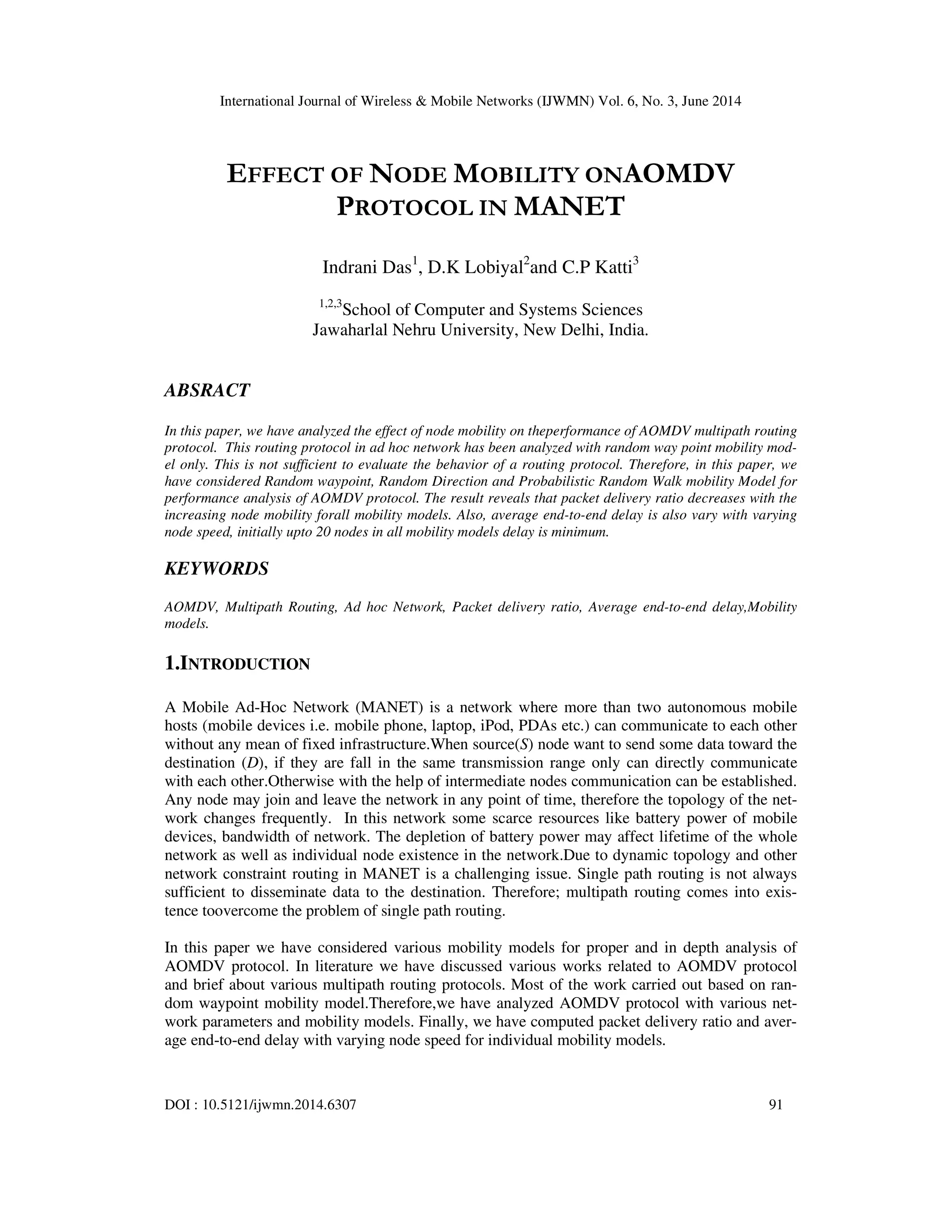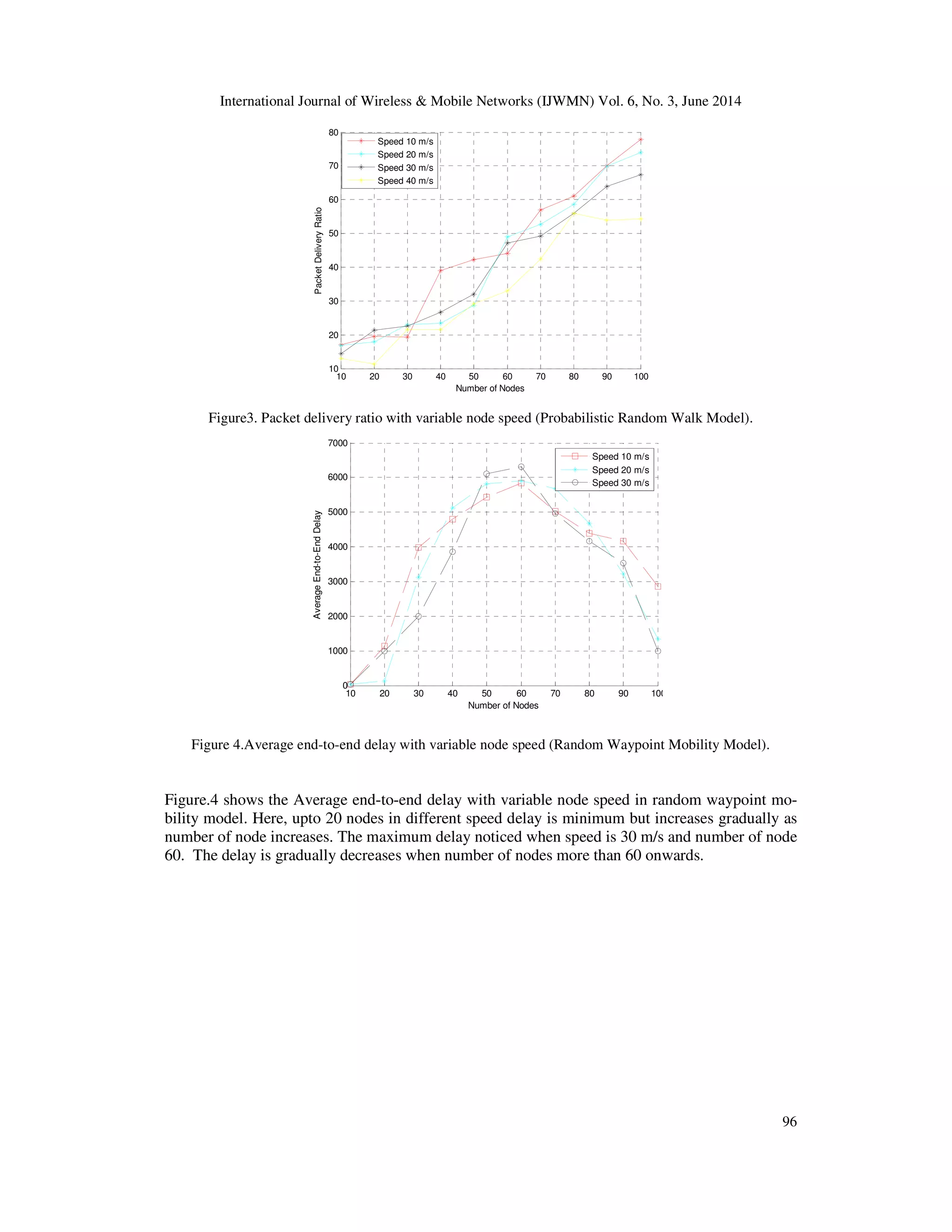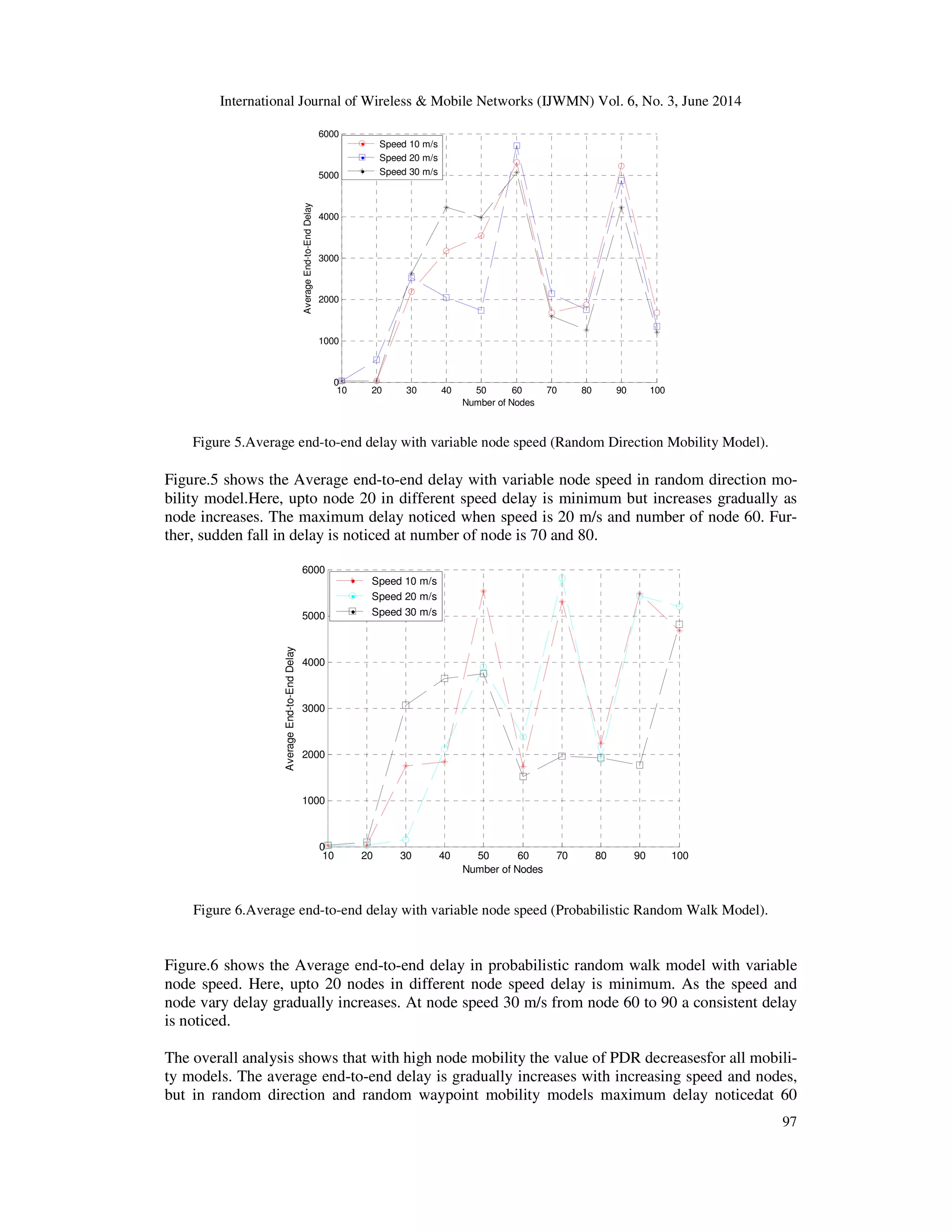This paper analyzes the impact of node mobility on the performance of the AOMDV multipath routing protocol in Mobile Ad Hoc Networks (MANETs) using various mobility models. Results indicate that the packet delivery ratio decreases with increasing node mobility across all models, while average end-to-end delay varies with node speed, peaking with 60 nodes. The AOMDV protocol performs best under the random waypoint mobility model in terms of packet delivery ratio and average delay, but its performance declines as node mobility increases.

![International Journal of Wireless & Mobile Networks (IJWMN) Vol. 6, No. 3, June 2014
92
The rest of the paper is organized as follows. In section II we have discussed various works re-
lated to multipath routing. In section III, various mobility models and AOMDV routing protocol-
briefly discussed. Results analysis and simulation work is presented in Section IV and finally, we
have concluded the paper in Section V.
2. RELATED WORKS
Multipath routing overcomes various problems occurs while data delivered through a single path.
The multipath routing protocols are broadly classified based on on-demand, table driven, and
hybrid. The following multipath routing protocols are used in MANETs. In [1] authors have com-
pared the performance of AOMDV and OLSR routing protocol with Levy-Walk and Gauss-
Markov Mobility Model. For the analysis they have considered varying mobility speed and the
traffic load in the network. Their results show that AOMDV protocol achieved higher packet de-
livery ratio and throughput compared to OLSR. Further, OLSR has less delay and routing over-
head at varying node density. In [2] authors only compared AOMDV and AODV routing protocol
with random way point mobility model. Different traffic source like TCP and CBR is considered.
The result shows that with increasing traffic both routing protocols performance degraded. In M-
DSR (Multipath Dynamic Source Routing) [5, 21] is an on demand routing protocol based on
DSR [12]actually it is a multipath extension of DSR. In SMR (Split Multipath Routing) [5, 15] is
an on demand routing protocol and extension of well- known DSR protocol. The main aim of this
protocol is to split the traffic into multiple paths so that bandwidth utilization goes in an efficient
manner. In GMR (Graph based Multipath Routing) [5, 9] protocol based on DSR, a destination
node compute disjoint path in the network using network topology graph.In MP-DSR [5, 13, 16]
is based on DSR; it is design to improve QoS support with respect to end-to-end delay. In [10,19]
authors have proposed an on-demand multipath routing protocol AODV-BR. But to establish
multipath it does not spend extra control message. This protocol utilizes mesh structure to provide
multiple alternate paths. In [8] authors have considered node-disjoint and link-disjoint multi-path
routing protocol for their analysis. The various mobility models Random Waypoint, Random Di-
rection, Gauss-Markov, City Section and Manhattanmodels are considered. Through the thorough
analysis they have shown that in Gauss markov mobility model multipath formation is less but
path stability is high. (The random direction model form larger number of multipath.) In [14] au-
thors have considered AODV and AOMDV protocol for their performance analysis with random
waypoint model. The result shows that AOMDV has more routing overhead and average end to
end delay compared to AODV. But AOMDV perform better in term of packets drops and packet
delivery. In [17] various energy models with Random Waypoint Mobility Model,Steady State
mobility model is used to analyze the energy overhead in AOMDV, TORA and OLSR routing
protocols. Results show that TORA protocol has highest energy overhead in all the energy mod-
els.In [22] performance of AOMDV protocol is analyzedfor different mobility models to investi-
gate how this protocol behaves in different mobility scenario. The results show that with increas-
ing node density, packet delivery ratio increases but with increasing node mobility packet deli-
very ratio decreases.
3. DESCRIPTION OF ROUTING PROTOCOL AND MOBILITY MODELS
In this section we have discussed brief about AOMDV routing protocol and various mobility
models considered for simulation work.
3.1 Ad Hoc On Demand Multipath Distance Vector (AOMDV)
Ad Hoc On Demand Multipath Distance Vector (AOMDV) [3, 5, 6, 11] protocol is a multipath
variation of AODV protocol. The main objective is to achieve efficient fault tolerance i.e. quickly](https://image.slidesharecdn.com/effectofnodemobilityonaomdvprotocolinmanet-140708054638-phpapp01/75/Effect-of-node-mobility-onaomdv-protocol-in-manet-2-2048.jpg)
![International Journal of Wireless & Mobile Networks (IJWMN) Vol. 6, No. 3, June 2014
93
recovery from route failure. The protocol computes multiple link disjoint loop free paths per route
discovery. If one path fails the protocol choose alternate route from other available paths. The
route discovery process is initiated only when to a particular destination fails. When a source
needs a route to destination will floods the RREQ for the destination and at the intermediate
nodes all duplicate RREQ are examined and each RREQ packet define an alternate route. How-
ever, only link disjoint routes are selected (node disjoint routes are also link disjoint). The desti-
nation node replies only k copies of out of many link disjoint path, i.e. RREQ packets arrive
through unique neighbors, apart from the first hop are replied. Further, to avoid loop ‘advertised
hop count’ is used in the routing table of node .The protocol only accepts alternate route with hop
count less than the advertised hop count. A node can receive a routing update via a RREQ or
RREP packet either forming or updating a forward or reverse path .Such routing updates received
via RREQ and RREP as routing advertisement.
3.2 Mobility Models
Mobility pattern of node plays a vital role in evaluation of any routing protocol in MANET. We
have considered various categories mobility models for acceptability of routing protocol. The
following mobility model we have considered in simulation work.
3.2.1Random Waypoint Model
The Random Waypoint (RWP) mobility model [4,7] is the only model which is used in maximum
cases for evaluation of MANET routing protocols. In this model nodes movement depends on
mobility speed, and pause time. Nodes are moving in a plane and choose a new destination ac-
cording to their speed. Pause time indicate that a node to wait in a position before moved to new
position.
3.2.2 Probabilistic Random Walk Model
In this model [4,7]nodes next position is determined by set of probabilities. A node can be move
forward, backward or remain in x and y direction depends on the probability defined in probabili-
ty matrix. There are three state of node is defined by 0 (current position), 1 (previous position)
and 2 (next position). Where, in the matrix P (a,b) means the probability that an node will move
from state a to state b.
3.2.3 Random Direction Model
The random direction model [4,7] is the further modification of Random waypoint mobility mod-
el.This model overcome the density wave problem occur in random waypoint model, where clus-
tering of nodes occur in a particular area of simulation. In Random Waypoint model this density
occurs in the center of the simulation area. Here, nodes are move upto the boundary of the simu-
lation area before moving to a new location with new speed and direction. When nodes are
reached to the boundary of simulation area, before changing to new position it pauses there for
sometimes. The random direction it chooses from 0 to 180 degrees. The same process is contin-
ued till the simulation time.](https://image.slidesharecdn.com/effectofnodemobilityonaomdvprotocolinmanet-140708054638-phpapp01/75/Effect-of-node-mobility-onaomdv-protocol-in-manet-3-2048.jpg)
![International Journal of Wireless & Mobile Networks (IJWMN) Vol. 6, No. 3, June 2014
94
4. SIMULATION SETUP AND RESULT ANALYSIS
For the simulation works we have used Bonn-Motion mobility generator [18] to generate the mo-
bility of nodes based on various mobility models. The most popular network simulator NS-2.34
[20] has beenused for simulation. Finally, in table-1 and table-2 different simulation parameters
and their values have been shown respectively..
Table 1. Simulation Parameters
Parameter Specifications
MAC Protocol IEEE 802.11
Routing Protocol AOMDV
Radio Propagation Model
Two-ray ground reflection
model
Channel type Wireless channel
Antenna model Omni-directional
Mobility Models
Random Waypoint,
Random Direction,
Probabilistic Random Walk
Table 2. Values of Simulation Parameters
Parameter Values
Simulation Time 1000s
Simulation Area (X *Y ) 1000 m x1000 m
Transmission Range 250 m
Bandwidth 2 Mbps
No. of Nodes 10,20,30,40,50,60,70,80.90,
100
Node speed 10,20,30,40 m/s
Figure1 shows Packet delivery ratio with Random Waypoint Mobility Model for different node
speeds. In this model AOMDV gives better packet delivery ratio with increasing node density.
But with the increasing node mobility PDR decreases due to frequent link breakage among nodes.
The maximum achievable value of PDR is 77.8%.](https://image.slidesharecdn.com/effectofnodemobilityonaomdvprotocolinmanet-140708054638-phpapp01/75/Effect-of-node-mobility-onaomdv-protocol-in-manet-4-2048.jpg)



![International Journal of Wireless & Mobile Networks (IJWMN) Vol. 6, No. 3, June 2014
98
nodes. The delay is gradually decreases 60 nodes onwards. In probabilistic random walk model at
node speed 30 m/s average delay in minimum as compare other speed.The overall performance of
AOMDV protocol performs better for Randomwaypoint mobility model as compared to other
mobility models.
5. CONCLUSIONS
We have evaluated the effect of node mobility on the performance of AOMDV multipath routing
protocol with different mobility models. For the performance analysis of the protocol packet de-
livery ratio is computed. It is evident from the results that AOMDV protocol perform better in
term of PDR and average end-to-end delay for Random Waypoint mobility model. But it is also
noticed that with higher node mobility PDR of AOMDV protocol decreases. In Probabilistic
Random walk model upto 70 nodes with various node mobility protocol performs better as com-
pared to others. In future, this multipath protocol can be investigated for different network topol-
ogies.
REFERENCES
[1] Gowrishankar. S, et al. (2010) “Analysis of AOMDV and OLSR Routing Protocols under Levy-
Walk Mobility Model and Gauss-Markov Mobility Model for Ad Hoc Networks”, (IJCSE) Inter-
national Journal on Computer Science and Engineering, Vol. 02, No. 04, 2010, pp. 979-986.
[2] Vivek B. Kute et al., (2013) “Analysis of Quality of Service for the AOMDV Routing Protocol”,
ETASR - Engineering, Technology & Applied Science Research Vol. 3,No. 1, pp.359-362.
[3] JiaziYi ,AsmaaAdnane, Sylvain David, and BenoîtParrein, (2011) “Multipath optimized link state
routing for mobile ad hoc networks”, Ad Hoc Networks, Vol. 9, No.1, pp. 28-47.
[4] RadhikaRanjan Roy, (2011)Handbook of Mobile Ad Hoc Networks for Mobility Models, First
Edition, Springer, New York Dordrecht Heidelberg London, ISBN 978-1-4419-6048-1 e-ISBN
978-1-4419-6050-4.
[5] Tsai, J., & Moors, T., (2006) “A review of multipath routing protocols: from wireless ad hoc to
mesh networks”, In Proceedings of ACoRN early career researcher workshop on wireless multi-
hop networking, Sydney.
[6] M. K. Marina and S. R. Das, (2006) “Ad-hoc on-demand multi-path distance vector
routing”,Wireless Communication Mobile Computing, Vol. 6, No. 7, pp. 969–988.
[7] Camp, Tracy et al., (2002) “A Survey of Mobility Models for Ad Hoc Network Research”, wire-
less communications & mobile computing (WCMC): special issue on mobile ad hoc networking:
research, trends and applications, Vol.2, No.5,pp. 483-502.
[8] Nicholas cooper et al., (2010) “Impact of Mobility models on multipath routing in mobile Ad hoc
Networks”, International Journal Of Computer Networks & Communications (IJCNC), Vol. 2,
No.1, pp.185-194.
[9] GunyoungKoh, Duyoung Oh and Heekyoung Woo, (2003) “A graph-based approach to compute
multiple paths in mobile ad hoc networks”, Lecture Notes in Computer Science Vol.2713, Sprin-
ger, pp. 3201-3205.
[10] M.T.Toussaint, (2003)“Multipath Routing in Mobile Ad Hoc Networks”, TU-Delft/TNO Trainee-
ship Report.
[11] S. Das, C. Perkins and E. Royer (2003) “Ad Hoc On Demand Distance Vector (AODV) Routing”,
IETF RFC3561.
[12] D. Johnson, (2003)“The Dynamic Source Routing Protocol for Mobile Ad Hoc Networks(DSR)”,
IETF Internet Draft, draft-ietf-manet-dsr-09.txt.
[13] E. Esmaeili, P. Akhlaghi, M. Dehghan, M.Fathi,(2006) “A New Multi-Path Routing Algorithm
with Local Recovery Capability in Mobile Ad hoc Networks”, In the Proceeding of 5th Interna-
tional Symposium on Communication Systems, Networks and Digital Signal Processing
(CSNDSP 2006), Patras, Greece, pp. 106-110.
[14] R.Balakrishna et al., (2010) “Performance issues on AODV and AOMDV for
MANETS”,International Journal of Computer Science and Information Technologies, Vol. 1, Is-
sue.2, pp. 38-43.](https://image.slidesharecdn.com/effectofnodemobilityonaomdvprotocolinmanet-140708054638-phpapp01/75/Effect-of-node-mobility-onaomdv-protocol-in-manet-8-2048.jpg)
![International Journal of Wireless & Mobile Networks (IJWMN) Vol. 6, No. 3, June 2014
[15] S. J. Lee and M. Gerla, (2001)
Networks”, In Proceedings of the IEEE ICC, pp. 3201
[16] R. Leung, J. Liu, E. Poon, Ah
namic Source Routing Protocol for Wireless Ad
Conference on Local Computer Networks (LCN), pp. 132
[17] Gowrishankar.S et al., (2010)
OLSR in MANET Using Various Energy Models”, Proceedings of the World Congress on Eng
neering and Computer Science,San Francisco, USA,
[18] Bonn Motion, http://net.cs.uni
[19] Sung-Ju Lee and Mario Gerla,
Conference on Wireless Communications and Networking
1311-1316.
[20] The Network Simulator. http://www.isi.edu/nsnam/ns/
[21] A. Nasipuri and S. R. Das,
the Proceedings of Eight
Networks, Boston, MA, pp.64
[22] Indrani Das, D.K Lobiyal and C.P Katti
Multipath Routing Protocol in MANET”, Published in the proceeding of fourth International Co
ference on Advances in Computing and Information Technology ( ACITY 2014 ), Volume Ed
tors: DhinaharanNagamalai,
pp.149-155.(ISBN : 978-1-
[23] The Math Works: http://www.mathworks.com
Authors
Indrani Das did her B. E. and M.Tech in Computer Science. She is working as Assistant
Professor in Computer Science department in Assam University (A Central University),
Assam, India. Presently, she is perusing her Ph.D from School of Computer and Systems
Sciences, Jawaharlal Nehru University, New Delhi, India. Her current research interest
includes Mobile Ad hoc Networks and Vehicular Ad hoc Ne
Daya K. Lobiyal Received his Bachelor of Technology in Computer Science from
Lucknow University, India, in 1988 an
Computer Science from Jawaharlal Nehru University, New Delhi, India, 1991 and 1996,
respectively. Presently, he is an Associate Professor in the School of Computer and Sy
tems Sciences, Jawaharlal Nehru Universit
bile Ad hoc Networks, Vehicular Ad Hoc Networks, Wireless Sensor Network and Video
on Demand.
C. P. Katti is a professor of computer science at Jawaharlal Nehru University. He r
ceived his Ph.D from IIT Delhi. He has published over 30 papers in journals of intern
tional repute. His area of research includes parallel computing, ad hoc networks
merical analysis.
f Wireless & Mobile Networks (IJWMN) Vol. 6, No. 3, June 2014
(2001) “Split Multipath Routing with Maximally Disjoint Paths in
Proceedings of the IEEE ICC, pp. 3201-3205.
R. Leung, J. Liu, E. Poon, Ah-Lot. Chan, B. Li, (2001) “MP-DSR: A QoS-Aware Multi
namic Source Routing Protocol for Wireless Ad-Hoc Networks”, In Proc. of 26th Annual IEEE
Conference on Local Computer Networks (LCN), pp. 132-141.
(2010) “Simulation Based Overhead Analysis of AOMDV, TORA and
OLSR in MANET Using Various Energy Models”, Proceedings of the World Congress on Eng
ing and Computer Science,San Francisco, USA, Vol.1.
http://net.cs.uni-bonn.de/wg/cs/applications/bonnmotion/
Ju Lee and Mario Gerla, (2000) “AODV-BR: Backup Routing in Ad hoc Networks”, IEEE
Conference on Wireless Communications and Networking Conference (WCNC- 2000),Vol.3, PP.
http://www.isi.edu/nsnam/ns/.
A. Nasipuri and S. R. Das, (1999)“On-demand multipath routing for mobile ad hoc networks”, In
dings of Eight IEEE International Conference on Computer Communications and
pp.64-70.
D.K Lobiyal and C.P Katti (2014) “Effect of Mobility Models on the Performance of
Multipath Routing Protocol in MANET”, Published in the proceeding of fourth International Co
ference on Advances in Computing and Information Technology ( ACITY 2014 ), Volume Ed
tors: DhinaharanNagamalai, SundarapandianVaidyanathan, May 24~25, 2014, Delhi, India,
-921987-22-9 ,DOI : 10.5121/csit.2014.4516).
http://www.mathworks.com
did her B. E. and M.Tech in Computer Science. She is working as Assistant
Professor in Computer Science department in Assam University (A Central University),
Assam, India. Presently, she is perusing her Ph.D from School of Computer and Systems
Jawaharlal Nehru University, New Delhi, India. Her current research interest
includes Mobile Ad hoc Networks and Vehicular Ad hoc Networks.
Received his Bachelor of Technology in Computer Science from
Lucknow University, India, in 1988 and his Master of Technology and Ph.D both in
Computer Science from Jawaharlal Nehru University, New Delhi, India, 1991 and 1996,
respectively. Presently, he is an Associate Professor in the School of Computer and Sys-
tems Sciences, Jawaharlal Nehru University, India. His areas of research interest are Mo-
bile Ad hoc Networks, Vehicular Ad Hoc Networks, Wireless Sensor Network and Video
is a professor of computer science at Jawaharlal Nehru University. He re-
Delhi. He has published over 30 papers in journals of interna-
rch includes parallel computing, ad hoc networks and nu-
f Wireless & Mobile Networks (IJWMN) Vol. 6, No. 3, June 2014
99
ally Disjoint Paths in Ad Hoc
Aware Multi-Path Dy-
Hoc Networks”, In Proc. of 26th Annual IEEE
“Simulation Based Overhead Analysis of AOMDV, TORA and
OLSR in MANET Using Various Energy Models”, Proceedings of the World Congress on Engi-
BR: Backup Routing in Ad hoc Networks”, IEEE
2000),Vol.3, PP.
demand multipath routing for mobile ad hoc networks”, In
International Conference on Computer Communications and
“Effect of Mobility Models on the Performance of
Multipath Routing Protocol in MANET”, Published in the proceeding of fourth International Con-
ference on Advances in Computing and Information Technology ( ACITY 2014 ), Volume Edi-
SundarapandianVaidyanathan, May 24~25, 2014, Delhi, India,](https://image.slidesharecdn.com/effectofnodemobilityonaomdvprotocolinmanet-140708054638-phpapp01/75/Effect-of-node-mobility-onaomdv-protocol-in-manet-9-2048.jpg)